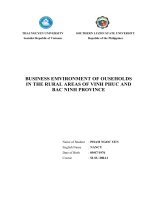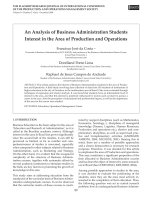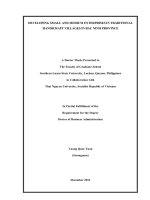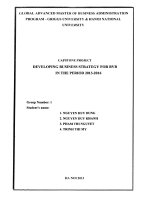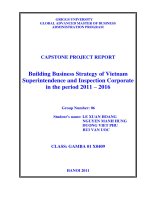Business environment of households in the rural areas of vinh phuc and bac ninh province
Bạn đang xem bản rút gọn của tài liệu. Xem và tải ngay bản đầy đủ của tài liệu tại đây (359.4 KB, 10 trang )
ABSTRACT
There have been a lot of studies on business environment. However, they concentrate
only on business environment of enterprises and companies of large scale, having their
business registration, or on business environment of a locality in general. The most
noticeable one among them is the research to build a Provincial Competitiveness Index
(PCI) of Vietnam Chamber of Commerce and Industry (VCCI) in combination with
Vietnam Competitiveness Improvement Project sponsored by the United States Agency
for International Development. PCI has become an important tool to measure and assess
business environment of private sector in 63 cities and provinces in Vietnam. The index
gets strongly active effect on improvement of business environment of the provinces. It
also helps local authorities find out obstacles for business of enterprises, especially
institution environment. More importantly, PCI helps provincial authorities to aware
importance of business environment improvement for their local enterprises, it is
considered an index reflecting capacity and efficiency of the local authorities.
However, the index has some certain limits on methodology. Firstly, the data were
collected from registered enterprises which are large-scaled and have experience and
good relations with local authorities, and normally operated in urban areas, but not
including business households (which play an important role in creating jobs and are
vulnerable and impacted by changes of the business environment). Therefore, difficulties
they met may differ from that of small-sized enterprises and business households.
In details, the nine factors impacting on business environment of the survey provinces in
the PCI include: Market entry cost; land access; transparency; time cost; informal chrges;
activeness of the State authorities; enterprise support service; human resource training;
legal policies. Some of these factors getting large impacts on business environment of
enterprises, such as time cost; legal policies … provide nearly insignificant impacts on
performance of business households, and vice versa, factors having large impacts on
performance of the households play no role in PCI (such as: capital).
Secondly, the data were collected from an indirect survey where a questionnaire was sent
to individual enterprises to get them filling into assessments and sending back. This may
cause a low accuracy of collected information (non-sample error).
On the other hand, in conformity to Vietnamese Law on Enterprises, a business
household has its corporate capacity as an enterprise. Therefore, the study method of PCI
with changes for some factors to get them suitable with a study of business environment
of households has scientific basis.
It is known that Vĩnh Phúc and Bắc Ninh, the two provinces adjacent to Hanoi (Vĩnh
Phúc is bounded by the North of Hà Nội, Bắc Ninh is bounded by the East of Hanoi),
have made significant contribution to economic development of the capital city for the
last years. In conformity to the National Plan by 2020, the two provinces shall be
important supports for Hanoi to get a sustainable economic development. Vĩnh Phúc City
and Bắc Ninh City (2 central cities of the two provinces) shall be satellite cities to help
Hanoi settle issues of environment, materials and human resources … Therefore, socioeconomic development of the two provinces gets much attention from the Government.
Being a province of long-standing culture with development of numerous traditional
villages specializing in bronzing, carpentry, ceramics …, Bắc Ninh has opportunities and
challenges completely different from that of Vĩnh Phúc, a province having a lot of
villages and communes with small trade of agricultural, forestry and aquatic products
(rice, bean, peanut, vegetable ...) in addition to its agricultural economy. Therefore,
economic development of the province can not be separated from development of
household business. It is necessary to get a favorable business environment for
development of household business. In urban areas, with development of enterprises of
various types, business environment of the households also has significant improvement.
However, in rural areas, business environment of the households does get much attention.
From the fact, the writer chooses the theme: “Study on business environment of
households in rural areas of Vĩnh Phúc Province and Bắc Ninh Province”.
The theme aims to study factors of the business environment impacting on
establishment and development of business households in rural areas of Vĩnh Phúc
Province and Bắc Ninh Province.
To study business environment of business households in rural areas of Vĩnh Phúc
Province and Bắc Ninh Province, the writer made a survey on 500 business households.
Sampling is made by the hierarchical random method, with layers of districts, communes
and households. In each province, 250 business households are sampled. Sampling is
made in 3 steps:
- Selection of districts: Five districts in a province were selected with proportional-topopulation-size (PPS) method on basis that the more business households the district had,
the higher the possibility to be sampled it had.
-
Vĩnh Phúc Province including: Lập Thạch, Yên Lạc, Vĩnh Tường, Tam Dương,
and Bình Xuyên Districts.
-
Bắc Ninh Province indluding: Tiên Du, Từ Sơn, Quế Võ, Thuận Thành and Yên
Phong Districts.
- Selection of communes: PPS method was also applied to choose five communes in each
district.
- Selection of households: In a commune, ten business households were selected on basis
that the rate of households having business registration/the ones having no registration
was 6/4.
The survey was completed in 2 weeks in each province. Data were input and cleaned by a
specialized software. The data then were dumped to a data processing software, Stata, to
make the analysis.
During the study, the formality index (FI) was built to assess business environment of the
households. The index was made on method of Building a Provincial Competitiveness
Index - PCI. The FI can be considered the weight mean value of component indexes
reflecting the local business environment. The two important issues in building the FI is
to determine component indexes and to estimate the weight of component indexes.
Although the FI method is similar to the PCI method, the study made some adjustments
to some factors during building the component indexes. In details: 3 factors “time cost;
legal institution; activeness of local authorities” in PCI were changed into the 3 factors:
“access to capital; business registration; support from State authorities” to get them
suitable to the business environment of the households.
In this theme, the weight of FI component indexes was estimated by a factor analysis and
regression.
Study results:
1. Analysis of business environment of households through survey data and Formality
Index (FI).
It is shown in the study that, in general, Vĩnh Phúc trends to get higher grade of
component indexes in comparison to Bắc Ninh. In addition, there is no significant
difference between communes of the two provinces for each component index. It is
assessed by the business households in the two provinces that their access to land gets
less trouble than other factors like capital, human resources and output market. Among
factors of macro business environment, market entry is accessed to be easy with
insignificant informal charges. However, awareness and accessibility to legal policies on
the households’ business is assessed to be weak in the two provinces.
This study chooses indexes reflecting business development level, including profit,
turnover growth, and assessment of the households on their business performance.
Estimation of the indexes for the two provinces and districts under the survey shows that
profit, turnover growth rate and rate of the households having positive assessment on
their business in Bắc Ninh Province is higher than those in Vĩnh Phúc Province.
There is a huge difference among the three indexes in the districts. In general, in the
districts having a rapid economic growth rate, the business households have higher profit
and turnover growth rate, and they get better assessment on business development. In
Vĩnh Phúc Province, Lập Thạch and Yên Lạc are two districts of the highest profits and
business growth rate among the ones under the survey. In Bắc Ninh Province, Từ Sơn
district has the highest average profit, and Thuận Thành district has the highest growth
rate among 5 districts under the survey. They are districts adjacent to Hanoi, with their
developed infrastructure system.
It is shown from the analysis that the factors of micro business environment including
accessibility to capital, input and output market of the households play the most
important role in the Household Formality Index. Accessibility to land also plays an
important role for business of the households. Support from State authorities for
development of the business households is considered an important factor for their
development. Factors of laws and informal charges have a small weight, showing their
insignificant contribution to competitiveness of the households.
Table 4.27: Weight of component indexes
Component indexes
Weight (w)
Access to land
0.0895
Access to capital
0.2282
Access to human resources and inputs of production/trade
Access to output market (Client)
0.1423
0.1460
Access to infrastructure
0.0474
Market entry indexes
0.0484
Informal costs
0.0474
Transparency of information
Support from State authorities
0.0604
0.1915
Source: Estimation on basis of survey data
The results show that value of the Household Formality Index ranges in 5,8 - 6,4. Vĩnh Phúc
has a slightly higher index in comparison to Bắc Ninh, (the FI is in score range of 10).
Table 4.28: Formality Index (FI) of provinces and districts
Vĩnh Phúc
Standard
Value
error
In general
6.182
0.070
Districts
Bắc Ninh
In general
Value
Standard
error
6.101
0.058
Districts
Lập Thạch
6.278
0.110
Yên Phong
5.882
0.107
Tam Dương
5.908
0.149
Quế Võ
6.087
0.141
Bình Xuyên
5.985
6.184
6.234
0.082
0.112
0.149
Tiên Du
Yên Lạc
Vĩnh Tường
6.118
0.116
Từ Sơn
6.403
0.115
Thuận Thành
6.075
0.110
Source: Estimation on basis of survey data
2. Assessment on impacts of business environment on business households’
performance.
* Factors impacting on business households’ performance
In order to assess impacts of business environment on business households’ performance,
econometric models are used with dependent variables of (1) Average monthly profit of
the business households in 2012; (2) Average monthly turnover of the business
households in 2012. Both of them directly reflect business performance of the households
through the most essential indicators of turnover and profit.
Model (1): Yi = β 0 + ∑ j β i j X i j + δ i DFI i
Where: Yi is average monthly profit of the households in 2012
(A)
Model (2): Yi = β 0 + ∑ j β i j X i j + ∑ k θ i k I i k + ε i
Where: Yi is average monthly turnover of the households in 2012 (B)
As for independent variables: Xj is a vector reflecting internal forces of the business
households, including demographic characteristics of the households’ managers
(qualifications, age, experience), business characteristics of the households (number of
operation years, business registration, business lines), scope of capital, human resource
and business space area.
We can find that profit and turnover of the households are in direct proportion with labor
and capital. In general, business households of higher scope of laborers and capital trend
to get higher profit and turnover. Business households in trade sector trend to get higher
profit than the households in industry or construction. Experience of the managers is
directly proportional to profit and turnover. Business households with female managers
trend to get lower profits. Households with business registration trend to get higher
turnover in comparison to those having no business registration. Similarly, business
households in Bắc Ninh trend to get higher turnover than that in Vĩnh Phúc with no clear
impact on their profit. On the other hand, impacts of DFI in the models are clear and have
their statistic meanings. It is shown in the results that, on average, if the districts get their DFI
increased with 1%, then the households shall get an increase of 3,3% for their profit and
increase of 8,4% for their turnover.
* Factors impacting on conversion into enterprise business
It is shown in the study that only 13,3% of business households with business registration
intends to converse into enterprise business. 56% of them are not aware of benefits of the
conversion. To get a more thorough study on impacts on their decision to converse into
enterprise business, we use the same econometric model as mentioned above:
Where,
is a binary variable, with a value of 1 if the households have intention to
converse into enterprise business and a value of 0 if not.
The model provides some facts that younger the younger the managers are, the higher the
intension of conversion is. Female managers get higher intention of conversion than male
managers. Business households in trade and service have lower intention of conversion
than that in industry/construction. Meanwhile, capital scope has a significant impact on
the trend of conversion into enterprise business: the higher capital scale is, the higher the
trend of conversion is. The households using loans have higher trend of conversion. The
results are proper, because in general, the households using loans are the ones having
higher capital scope or having their plans for business development. On the other hand,
scope of business space and human resource has no clear relation to the intention of
conversion.
DFI gets an active impact on the decision to converse into enterprise business. However,
it is shown in the analysis of component indexes that a better market accessibility and a
low index of market entry have an active impact on the decision of conversion. We can
see in the results that opportunities in the output market have a significant impact on the
business households. When the output market is potential and accessible, the households
trend to decide to converse into enterprise business to take full advantage of the market
opportunities.
Among factors of macro economic environment, only the index of “Assistance from State
authorities” has its statistic meanings. “Assistance from State authorities” is actually the
households’ viewpoint on activeness of local authorities. In localities where the business
households have a positive view on the role of State authorities in their business
performance, the households are more possible to converse into enterprise business than
in other places.
* Factors impacting on decision to get business registration
Among the survey samples, there are 270 households having business registration and
230 households having no business registration. Among the households without business
registration, only 21% of them have intention to get their business registration. To study
factors impacting to decision to get business registration of the households without
business registration certificates, an econometric model is applied, with the dependent
variable of value 1 if the household has intention to get business registration and of value
0 if the household has no intention to get business registration.
The results show that scale of capital has a significant impact on the households’ decision
to get business registration. It means that business households of higher capital trend to
get more intention to register their business in comparison to that of lower capital.
Business households with no loan have more trends to formalize their business than the ones
with loans. Furthermore, land impact has a reverse relation, that is, business households with
small business space have higher trend to get business registration than the ones with larger
business space. A reason for this lies in the fact that the formalization shall help the
households get loans and hire/purchase land more easily, solving their existing difficulties for
capital and land. Households having managers with high school education or higher trend
to get business registration more than the ones having managers with lower education.
Business households in service have higher trend to get business registration in
comparison to the others.
Therefore, in localities having favorable environment for the households to enlarge their
business space and easily employ high quality laborers, the households have higher trend
to get their business registration. On the other hand, the households having difficulties in
accessing to the output have higher trend to get business registration. The reason lies may
be that in localities having difficulties in accessing to the output market, and
formalization of the business shall help the households get better voice, and get more
trust from customers, and get easier in transacting with customers and finding their
markets.
Summary of Findings
1. On basis of collected information from the survey on business environment in Vĩnh
Phúc and Bắc Ninh provinces, the thesis gets an analysis on business environment of the
households in the two provinces through analyzing components of the business
environment. It is shown that the business households are facing with difficulties: limited
borrowing capacity, narrow business space and low quality human resource. Moreover,
market price fluctuation and limited infrastructure, especially electricity and road system,
provide numerous difficulties for the business households. Although informal charges of
the households are insignificant, the assistance from State authorities is also insignificant.
2. The main method applied by the writer to define the formality index is based on the
provincial competitiveness index (PCI) on business environment for private economic
sector annually built by VCCI. The main point here is how to select components of
business environment so as to be suitable with business households. From qualitative
studies in the survey area and quantitative studies, the writer believes that the research
selected the most exact components of business environment of the households in rural
areas of the two provinces.
3. The most important result of the research is that the writer, on basis of the collected
information, could define a set of indexes to evaluate competitiveness of business
environment in Vĩnh Phúc and Bắc Ninh. A remarkable point in this research is that the
indexes can be defined at district level. Basically, the results are similar to the provincial
competitiveness index built by VCCI.
4. According to the analysis, factors of input access and output access of the business
households play the most important role in the competitiveness index of the households.
The factors get direct impacts on business performance of the households, and they are
main factors to promote competitiveness of the households. The next important ones
playing an important role for business performance of the households are capital and
land. However, legal stipulations and informal charges get a small weight in the general
competitiveness index, proving an insignificant contribution to competitiveness of the
households. In order to improve competitiveness of the households, the State should
provide convenience for access to output market, inputs, capital and land of the
households.
5. It is shown by the analysis that the formality index at district level and commune level
is in the range of 5.9 to 6.6. Vĩnh Phúc has the index of 6,18 which is higher than that of
Bắc Ninh (6.15) show that the business environment of the business households in rural
area in Vinh Phuc is better than business environment of the business households in Bac
Ninh. The result is similar to the Provincial Competitiveness Index (PCI) of year 2010
built by VCCI. In details, PCI of Vĩnh Phúc and Bắc Ninh is 66.7% and 65.7%
respectively (in a score range of 100%, and FI in a score range 1 of 10).
6. The researcher used modeling method to determine factors impacting on business
performance of the households in the two provinces. Another important objective of the
research to clarify the households’ decision to get business registration or not and to
convert into a enterprise business or not was also made by the modeling method in
combination with the normal statistical analysis methods. It is shown that the households’
decision to convert into enterprise business or not and to get business registration or not is
significantly impacted by business environment factors: labor access, market access and land
access. Meanwhile, the role of macro environment factors is limited.
7. The writer believes that the research results are meaningful and satisfactory in
evaluating business environment of the households in the two provinces. However, the
research was conducted in a small scale, in the two provinces of similar socio-economic
features, so the picture of the households’ business environment cannot be generalized in
a national scale.

